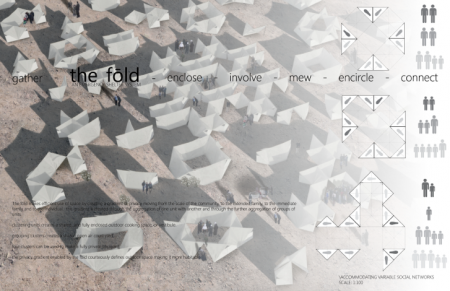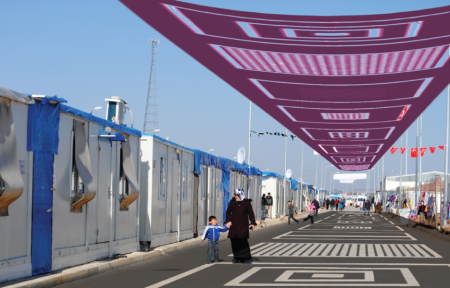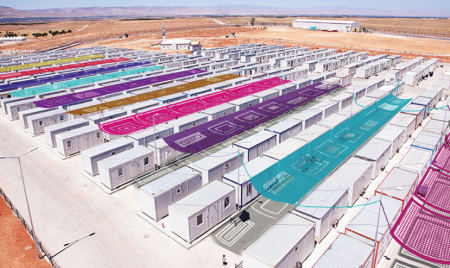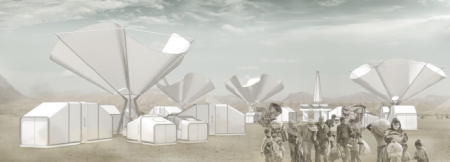Why is Shade Important to Humanity?
Shelter is the first priority for anyone displaced by natural disaster or conflict. Protection from elements is often the difference between life and death.
And humanitarian crises spurred by conflict and natural disasters are on the rise. There were 65.6 million forcibly displaced people in 2016—a number that has increased from 33.9 million in 1997.1
Recent data shows that natural disasters have increased in intensity: the number of natural disasters decreased in 2016 compared to 2015, but the number of people affected by them doubled, and during the same year-to-year comparison total damage costs increased from $90 billion in 2015 to $147 billion in 2016.2
Likewise, humanitarian relief experts say that these situations increasingly have become long-term3 and this presents new challenges: How to provide schooling? What about maintaining one’s culture? How to create community?
Meeting New Needs with Shade Design
Architects and designers are increasingly addressing the challenges of designing for displaced communities by thinking beyond shelter from the elements to design also for emotional, cultural and community needs of the displaced population.
The following conceptual designs take different approaches to providing shade as a component of shelter during humanitarian crises.
The Fold is a modular tent system inspired by the geometry found in origami. The system integrates fabric and corrugated plastic to produce the structure, the envelope and the furnishings for the shelter.

Architects Amber LaFontaine and Sophia Yi made personal privacy combined with community connections a priority when thinking about the needs of displaced people. Their conceptual design allows users displaced by natural disasters or manmade conflicts to configure the tents both for individual privacy without sacrificing security and communal living.

Displaced people leave behind all of the visual markers of their culture, which can be disorienting. For Brooklyn-based architect Sanna Shah, shade could fill dual purposes: provide sun protection and create a reminder of home.
She created a shade design concept called NouraSouria that strives to provide refugees from the Syrian Civil War with cultural and spiritual connections to home by memorializing architectural history and visual narratives lost during the war. Large swaths of fabric hanging between existing infrastructure contain cutouts that replicate motifs found in the courtyard arcade of the Great Mosque of Aleppo, now seriously damaged by fighting. When the sun passes overhead, the motifs appear in the shade.

Wayfinding could also be incorporated into the design by using different colors of fabric to differentiate the otherwise identical housing of a refugee camp.

Colombian architect Felipe Guerrero Castillo was inspired to create a shade design concept after volunteering in the emergency response to devastating floods and mud slides in Mocoa in the southwestern part of his country.
His concept, Resilient Communities, recognizes the human need to re-establish community ties in the aftermath of a natural disaster. Three modules made of lightweight fabric and framing address community integration, shelter and basic hygiene access.
The Extrude module is a structural frame wrapped in fabric to provide housing.

The Core module provides shade and captures rainwater to consumption by the community, while the Flip module includes a toilet and wash basin, and a fabric exterior whose roof collects rain water for use in the wash basin.

Together the three modules provide basic necessities of shelter and hygiene, while simultaneously restoring community ties.

Shade serves a very elemental purpose: protection from sunlight and heat. However, it can do that and much more when designers connect with the emotional, cultural and community needs of displaced populations.
View more new thinking in shade design at futureofshade.com.
1 “Global Trends: Forced Displacement in 2016,” http://www.unhcr.org/globaltrends2016/
2 “World Humanitarian Data and Trends 2017,” http://interactive.unocha.org/publication/datatrends2017/#natural-disaster
3 “Humanitarian Crises are on the Rise. By 2030, This is How We’ll Respond,” https://www.weforum.org/agenda/2016/11/humanitarian-crisis-are-on-the-rise-by-2030-this-is-how-well-respond/